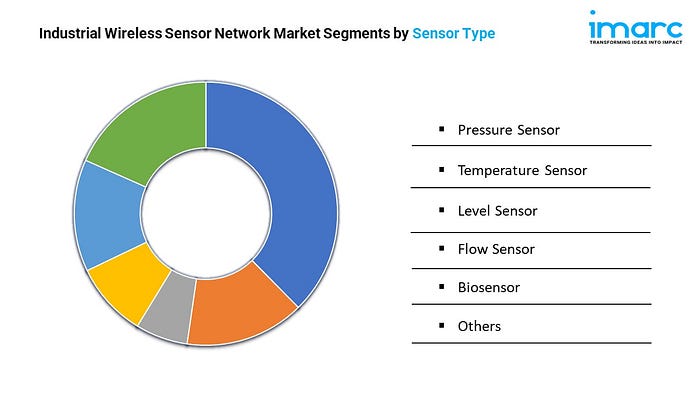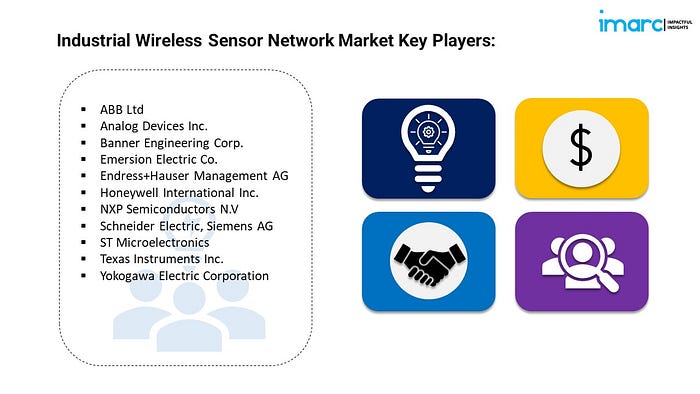Global Industrial Wireless Sensor Network Industry: Key Statistics and Insights in 2025–2033
Summary:
- The global industrial wireless sensor network market size reached USD 8.0 Billion in 2024.
- The market is expected to reach USD 29.5 Billion by 2033, exhibiting a growth rate (CAGR) of 14.82% during 2025–2033.
- North America leads the market, accounting for the largest industrial wireless sensor network market share.
- Software accounts for the majority of the market share in the component segment, as it provides the necessary platforms for data visualization, system integration, and predictive analytics.
- Flow sensor holds the largest share in the industrial wireless sensor network industry.
- Process monitoring remains a dominant segment in the market due to the growing need for automation and predictive maintenance.
- Based on the end use, the market has been divided into automotive, food and beverages, manufacturing, mining, oil and gas, utilities, and others.
- The rising demand for automation is a primary driver of the industrial wireless sensor network market.
- Advancements in wireless technology are reshaping the industrial wireless sensor network market.
Request for a sample copy of this report: https://www.imarcgroup.com/industrial-wireless-sensor-network-market/requestsample
Industry Trends and Drivers:
● Increasing demand for automation:
Automation in industrial processes requires continuous real-time monitoring of equipment and operations. IWSNs facilitate this by collecting data from sensors deployed across various machines and systems. These sensors monitor critical parameters such as temperature, pressure, humidity, and vibration, allowing for precise control of automated processes without the need for manual intervention. Automation is all about optimizing efficiency and productivity. By integrating IWSNs into automated systems, industries can minimize human errors and improve process accuracy. Wireless sensors can communicate with central control systems instantly, ensuring smooth coordination of automated tasks. This helps reduce bottlenecks, accelerate production, and enhance overall operational efficiency.
● Enhanced data collection and analysis:
IWSNs allow industries to collect data in real-time from various sensors deployed across machinery, equipment, and operational systems. This real-time data provides immediate insights into performance, enabling companies to respond quickly to changing conditions. For instance, manufacturing plants can monitor production lines continuously and make adjustments instantly, improving efficiency and reducing waste. With enhanced data collection, industries can monitor various processes more accurately and in greater detail. IWSNs provide continuous streams of information, such as temperature, pressure, vibration, and humidity levels, which help optimize production processes. The ability to gather and analyze large volumes of data allows companies to identify inefficiencies, reduce downtime, and fine-tune processes, leading to better productivity.
● Advancements in wireless technology:
Advancements in wireless communication standards, such as 5G, Wi-Fi 6, and LoRaWAN, are dramatically increasing data transmission speeds and bandwidth. These faster speeds and larger capacities enable IWSNs to handle high volumes of sensor data more efficiently. This is especially important in data-intensive industries like manufacturing and oil and gas, where real-time monitoring and control are critical. Higher speeds allow for quicker data transmission between sensors and control systems, leading to faster decision-making and more responsive operations. Recent developments in wireless technology have extended the range of communication for IWSNs, enabling them to cover larger industrial areas.
We explore the factors driving the growth of the market, including technological advancements, consumer behaviors, and regulatory changes, along with emerging industrial wireless sensor network market trends.
Industrial Wireless Sensor Network Market Report Segmentation:
Breakup By Component:
- Hardware
- Software
- Service
Software represents the largest segment because it facilitates seamless integration, data processing, and analytics, which are crucial for managing and optimizing sensor networks in industrial settings.
Breakup By Sensor Type:

- Pressure Sensor
- Temperature Sensor
- Level Sensor
- Flow Sensor
- Biosensor
- Others
Flow sensor accounts for the majority of the market share due to its widespread use in industries like oil & gas, water management, and manufacturing, where monitoring fluid and gas flow is critical.
Breakup By Application:
- Machine Monitoring
- Process Monitoring
- Asset Tracking
- Safety and Surveillance
Process monitoring exhibits a clear dominance in the market as industries prioritize real-time tracking and optimization of production processes to improve efficiency and reduce downtime.
Breakup By End Use:
- Automotive
- Food and Beverages
- Manufacturing
- Mining
- Oil and Gas
- Utilities
- Others
Based on the end use, the market has been divided into automotive, food and beverages, manufacturing, mining, oil and gas, utilities, and others.
Breakup By Region:
- North America (United States, Canada)
- Asia Pacific (China, Japan, India, South Korea, Australia, Indonesia, Others)
- Europe (Germany, France, United Kingdom, Italy, Spain, Russia, Others)
- Latin America (Brazil, Mexico, Others)
- Middle East and Africa
North America enjoys the leading position in the industrial wireless sensor network market owing to the early adoption of advanced technologies, strong industrial base, and increasing investments in Internet of Things (IoT) and automation.
Top Industrial Wireless Sensor Network Market Leaders:
The industrial wireless sensor network market research report outlines a detailed analysis of the competitive landscape, offering in-depth profiles of major companies. Some of the key players in the market are:

- ABB Ltd
- Analog Devices Inc.
- Banner Engineering Corp.
- Emersion Electric Co.
- Endress+Hauser Management AG
- Honeywell International Inc.
- NXP Semiconductors N.V
- Schneider Electric
- Siemens AG
- ST Microelectronics
- Texas Instruments Inc.
- Yokogawa Electric Corporation
Note: If you require any specific information that is not covered currently within the scope of the report, we will provide the same as a part of the customization.
About Us:
IMARC Group is a global management consulting firm that helps the world’s most ambitious changemakers to create a lasting impact. The company provide a comprehensive suite of market entry and expansion services. IMARC offerings include thorough market assessment, feasibility studies, company incorporation assistance, factory setup support, regulatory approvals and licensing navigation, branding, marketing and sales strategies, competitive landscape and benchmarking analyses, pricing and cost research, and procurement research.
Contact Us:
IMARC Group
134 N 4th St. Brooklyn, NY 11249, USA
Email: sales@imarcgroup.com
Tel No:(D) +91 120 433 0800
United States: +1–631–791–1145
